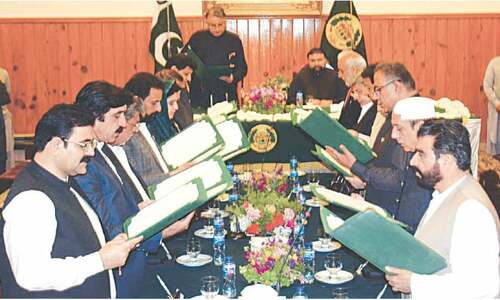TODAY, when Persian is no longer a language of our literature and culture, many would find it hard to believe that until about a century-and-a-half ago Persian was the prestige language in this part of the world.
In the subcontinent, Persian was as preferred and prestigious a language as English is in our society today, that is, not a language but a passport to success. Zia Ahmed Badayuni in his Masalik-o-Manazil has rightly mentioned that during the Mughal era Persian was the official language and anyone, whether Muslim or otherwise, seeking a position at the royal court, or any government entity, had to learn Persian well.
As a result, many great scholars and poets emerged from the subcontinent and it is a fact that many of the early Persian dictionaries were compiled here. At that time Persian lexicography in Iran was not as developed. Yet the native speakers of Persian from Iran named the local literary school ‘Sabk-i-Hindi’ or the Indian Style. Among the prominent scholars and poets of Persian during the last decades of Mughal era was Imam Bakhsh Sehbai.
Imam Bakhsh Sehbai was a poet, prosodist, pedagogue, lexicologist, prose writer and scholar of Persian. His ancestors had migrated from Thanesar, a historic town in Haryana, to Delhi. Sehbai was born in Delhi’s Koocha Chailan in 1221 Hijri, or 1806-07 AD, but no exact date of his birth is mentioned in any source. At that time, Delhi was a city rich in learning and culture. So Sehbai was able to learn quite a few contemporary disciplines from some of the well-known scholars of his time. Sir Syed Ahmed Khan in his Aasaar-us-Sanaadeed, while appreciating Sehbai’s excellent command over different branches of knowledge, especially stressed Sehbai’s profound study of prosody, lexicology and rhetoric.
In 1840, the British decided to hire a scholar of Persian to teach at Delhi College. They sought Mufti Sadruddin Azurda’s advice. Azurda said there were only three persons in Delhi who could do the job well as they had amazing command over the language: Mirza Asadullah Khan Ghalib, Hakeem Maumin Khan Maumin and Imam Bakhsh Sehbai.
Sehbai got the job as Ghalib had demanded a protocol at the time of interview, which was not accorded, so he went back. Maumin asked for Rs100 per month and the request was declined. Sehbai was appointed for Rs40 a month.
But surprisingly, Sehbai restricted himself almost entirely for pedagogical works and most of his books are curriculum-related. Though he was capable of writing much profoundly and extensively, Sehbai wrote many commentaries and explanatory works on Persian books usually taught at that time. Zia Ahmed Badayuni has mentioned these works by Sehbai: Kulliyat-i-Sehbai (which consists of 14 booklets and his divan), Sharh-i-Shabnam, Sharh-i-Risala Muammiyat, Sharh-i-Husn-o-Ishq (by Naimat Khan Aali), Sharh-i-Maqamaat, Sharh-i-Alfaz-i-Mushkila, Sharh-i-Javahir-ul-Huroof, Sharh-i-Seh Nasr-i-Zahoori, Sharh-i-Meena Bazaar, Sharh-i-Panj Ruqa’a, Radd-i-Sirajuddin Khan Arzoo, Intikhab-i-Davaveen and Urdu translation of Hadaiq-ul-Balaghat. Just three of these books are in Urdu and the rest are in Persian.
Today, Urdu prosody, rhetoric and allied subjects have been researched and written about to quite a vast extent. But about a century-and-a-half ago it was not so and some of the scholars who began writing on these subjects in Urdu was Imam Bakhsh Sehbai.
There are different accounts as to what caused Sehbai’s tragic death at the hands of the British during the 1857 war of freedom. Some writers have written that Sehbai took part in freedom war and was punished for that ‘crime’. But there are no proofs that Sehbai had taken any active part in the struggle for freedom. Some other writers have written that he was clandestinely taking part in the struggle to topple the British Raj and was killed for that reason.
But more credible is the account of some writers who say that a British soldier with bad intentions tried to enter the women’s quarters in a house in Koocha Chailan and was injured by the residents in retaliation. The British army ordered to arrest all the males in the vicinity and they were shot dead by the side of Yamuna River. Sehbai was among the ones mercilessly killed.
Sehbai’s exact date of death too is not properly recorded, at least not in the works written in Urdu, and most of the scholars who have appraised and praised Sehbai’s works echo just one mantra: Sehbai was mercilessly killed in the aftermath of 1857 war of freedom. He was shot along with his two sons and scores of others, whose dead bodies were thrown into Yamuna River, without mentioning any date.
Even Muhammad Zakir Husain in his dissertation on Sehbai, titled Imam Bakhsh Sehbai Ki Adabi Khidmaat published from Patna in 2002, has just repeated that Sehbai was martyred during 1857 freedom war.
Published in Dawn, March 14th, 2022












































Dear visitor, the comments section is undergoing an overhaul and will return soon.